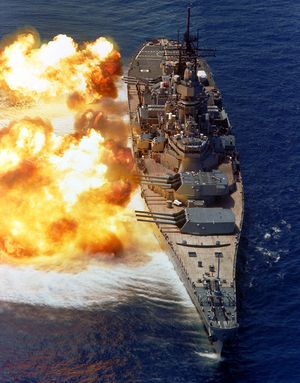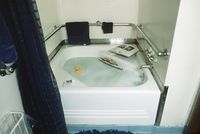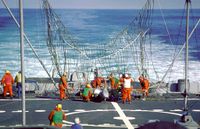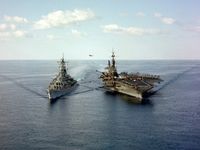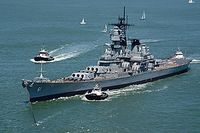Uss Iowa
USS Iowa (BB-61) is a retired battleship, the lead ship of her class, and the fourth in the United States Navy to be named after the state of Iowa. Owing to the cancellation of the Montana-class battleships, Iowa is the last lead ship of any class of United States battleships and was the only ship of her class to serve in the Atlantic Ocean during World War II.
During World War II, she carried President Franklin D. Roosevelt across the Atlantic to Mers El Kébir, Algeria, en route to a conference of vital importance in 1943 in Tehran with Prime Minister Winston Churchill of the United Kingdom, and Joseph Stalin, leader of the Soviet Union. When transferred to the Pacific Fleet in 1944, Iowa shelled beachheads at Kwajalein and Eniwetok in advance of Allied amphibious landings and screened aircraft carriers operating in the Marshall Islands. She also served as the Third Fleet flagship, flying Admiral William F. Halsey's flag at the Japanese surrender in Tokyo Bay.
During the Korean War, Iowa was involved in raids on the North Korean coast, after which she was decommissioned into the United States Navy reserve fleets, better known as the "mothball fleet." She was reactivated in 1984 as part of the 600-ship Navy plan and operated in both the Atlantic and Pacific Fleets to counter the recently expanded Soviet Navy. In April 1989, an explosion of undetermined origin wrecked her No. 2 gun turret, killing 47 sailors.
Iowa was decommissioned for the last time in October 1990 after 19 total years of active service and was initially stricken from the Naval Vessel Register (NVR) in 1995 before being reinstated from 1999 to 2006 to comply with federal laws that required retention and maintenance of two Iowa-class battleships. In 2011 Iowa was donated to the Los Angeles–based non-profit Pacific Battleship Center and was permanently moved to Berth 87 at the Port of Los Angeles in 2012, where she was opened to the public as the USS Iowa Museum.
Construction
- Wikipedia article: Iowa-class battleship
Ordered in July 1939, USS Iowa was laid down at New York Naval Shipyard in June 1940. She was launched on 27 August 1942, sponsored by Ilo Wallace (wife of Vice President Henry Wallace), and commissioned on 22 February 1943 with Captain John L. McCrea in command.
USS Iowa's main battery consisted of nine 16 in (406 mm)/50 caliber Mark 7 guns, which could fire 2,700 lb (1,200 kg) armor-piercing shells 20 nmi (23 mi; 37 km). Her secondary battery consisted of twenty 5 in (127 mm)/38 cal guns in twin mounts, which could fire at targets up to 12 nmi (14 mi; 22 km) away. With the advent of air power and the need to gain and maintain air superiority came a need to protect the growing fleet of Allied aircraft carriers; to this end, Iowa was fitted with an array of Oerlikon 20 mm and Bofors 40 mm anti-aircraft guns to defend Allied carriers from enemy airstrikes.
- Wikipedia article: Armament of the Iowa class battleship
World War II (1943–1945)
Shakedown and service with the Atlantic Fleet
On 24 February 1943, Iowa put to sea for a shakedown cruise in the Chesapeake Bay and along the Atlantic coast. She got underway on 27 August for Argentia, Newfoundland, to counter the threat of the German battleship Tirpitz which was reportedly operating in Norwegian waters, before returning to the United States on 25 October for two weeks of maintenance at the Norfolk Navy Yard.
When Iowa was selected to ferry President Franklin D. Roosevelt to the Cairo and Tehran Conferences, she was outfitted with a bathtub for Roosevelt's convenience. Roosevelt, who had been paralyzed in 1921, would have been unable to make effective use of a shower facility. In November 1943, Iowa carried President Roosevelt, Secretary of State Cordell Hull, Roosevelt's Chief of Staff Admiral William D. Leahy, Chief of Staff of the Army General George C. Marshall, Chief of Naval Operations Ernest King, Commanding General of the US Army Air Forces Henry "Hap" Arnold, Harry Hopkins, and other military leaders to Mers El Kébir, Algeria, on the first leg of the journey to the Tehran Conference. Among the vessels escorting Iowa on this trip was the destroyer William D. Porter which was involved in several mishaps, the most serious of which involved a torpedo drill which went awry when a torpedo from William D. Porter discharged from its tube and headed toward Iowa. On being warned, Iowa turned hard to avoid being hit by the torpedo and the torpedo detonated in the ship's wake. Iowa was undamaged and trained her main guns on William D. Porter, concerned that the smaller ship may have been involved in some sort of assassination plot.
Iowa completed her presidential escort mission on 16 December by returning the President to the United States. Roosevelt addressed the crew of Iowa prior to leaving by stating, "... from all I have seen and all I have heard, the Iowa is a 'happy ship,' and having served with the Navy for many years, I know—and you know—what that means." He also touched on the progress made at the conference before concluding his address with "... good luck, and remember that I am with you in spirit, each and every one of you."
Reactivation (1982–1990)
As part of President Ronald Reagan's and Secretary of the Navy John F. Lehman's effort to create an expanded 600-ship Navy, Iowa was reactivated in 1982 and moved under tow to Avondale Shipyard near New Orleans, Louisiana, for refitting and equipment modernization in advance of her planned recommissioning. During the refit, Iowa had all of her remaining Oerlikon 20 mm and Bofors 40 mm anti-aircraft guns removed, due to their ineffectiveness against modern fighter jets and anti-ship missiles. Additionally, the two 5 in (127 mm) gun mounts located at mid-ship and in the aft on the port and starboard sides of the battleship were removed.
Iowa was then towed to Ingalls Shipbuilding, Pascagoula, Mississippi, where over the next several months, the battleship was upgraded with the most advanced weaponry available. Among the new weapons systems installed were four MK 141 quad cell launchers for 16 AGM-84 Harpoon anti-ship missiles, eight Armored Box Launcher mounts for 32 BGM-109 Tomahawk missiles, and a quartet of Phalanx Close-in weapon system Gatling guns for defense against enemy anti-ship missiles and enemy aircraft. Sometime after June 1986, Iowa was the first battleship to receive the RQ-2 Pioneer Unmanned Aerial Vehicle (UAV). She could carry up to eight of the remotely controlled drones, which replaced the helicopters (although helicopters were not carried by battleships) previously used to spot for her nine 16 inch (410 mm)/50 cal Mark 7 guns. Also included in her modernization were upgrades to radar and fire-control systems for her guns and missiles, and improved electronic warfare capabilities. Armed as such, Iowa was formally recommissioned on 28 April 1984, ahead of schedule, within her budget at a cost of $500 million, and under the command of Captain Gerald E. Gneckow. In order to expedite the schedule, many necessary repairs to Iowa's engines and guns were not completed and the mandatory Navy Board of Inspection and Survey (InSurv) inspection was skipped.
Shakedown and NATO exercises (1984–1989)
From April to August 1984, Iowa underwent refresher training and naval gunfire support qualifications at Guantanamo Bay, Cuba and the Puerto Rican Operating area. After a short period in her new home port of Norfolk, Virginia, she spent the two periods of time during the rest of 1984 and early 1985 conduction "presence" operations shakedown in the area around Central America. During this time she transited the Panama Canal to operate off the west coast of Central America while also conducting people-to-people humanitarian operations, including in El Salvador, Costa Rica and Honduras, before returning to the United States in April 1985 for a period of routine maintenance.
An overhead view of a battleship, showing the ship's teardrop shaped hull. Nine gun barrels on three turrets are pointed to the top of the image, with smoke and fire visible form all nine gun barrels and a concussive effect on the water below the guns. Visible from the overhead image are the 8 armored box launchers for the battleship's 32 Tomahawk Missiles. Iowa fires a full broadside of nine 16-inch (406 mm)/50-caliber and six 5-inch (127 mm)/38 cal guns during a target exercise near Vieques Island, Puerto Rico, on 1 July 1984. Shock waves are visible in the water.
In August 1985, Iowa joined 160 other ships for Exercise Ocean Safari, a NATO naval exercise aimed at testing NATO's ability to control sea lanes and maintain free passage of shipping. Owing to bad weather, Iowa and the other ships were forced to ride out rough seas, but Iowa made use of the time to practice hiding herself from enemy forces. While serving with the exercise force, Iowa crossed the Arctic Circle. In October, she took part in Baltic operations, and fired her phalanx guns, 5 in (127 mm) guns, and 16 in (406 mm) guns in the Baltic Sea on 17 October while operating with US and other allied ships. After these operations during which she visited Le Havre in France, Kiel in Germany, Copenhagen (where the current Crown Prince of Denmark visited the ship as a schoolboy) and Aarhus in Denmark, and Oslo in Norway where the King of Norway was entertained at lunch, she returned to the United States.
Beginning on 17 March 1986, Iowa underwent her overdue InSurv inspection. The inspection, which Iowa ultimately failed, was conducted under the supervision of Rear Admiral John D. Bulkeley. Bulkeley found that the ship was unable to achieve her top speed of 33 kn (38 mph; 61 km/h) during a full-power engine run, and recommended to the Chief of Naval Operations and Lehman that Iowa be taken out of service immediately. Rejecting this advice, Lehman instead instructed the leaders of the Atlantic Fleet to ensure that Iowa's deficiencies were corrected.
Afterward, Iowa returned to the waters around Central America and conducted drills and exercises while providing a military presence to friendly nations. On 4 July, President Ronald Reagan and First Lady Nancy Reagan boarded Iowa for the International Naval Review, which was held in the Hudson River. On 25 April, Captain Larry Ray Seaquist assumed command of the battleship and her crew during Naval Gunfire Support requalification off Vieques Island near Puerto Rico.
On 17 August, 1986, Iowa set sail for the North Atlantic, and in September she participated in Exercise Northern Wedding by ferrying Marines ashore and assisting helicopter gunships. During the exercise Iowa fired her main guns at Cape Wrath range in Scotland in support of a simulated amphibious assault on 5–6 September, firing a total of 19 16-inch (406 mm) shells and 32 5-inch (127 mm) shells during a 10-hour period and operating in rough seas. During the live fire exercise, a small number of Iowa marines were put ashore to monitor the fall of shot and advise the battleship of gunnery corrections. Afterward, Iowa visited ports, including Portsmouth, in England and Germany before returning to the United States in October.
A large net on the back end of a ship. Several orange-clad crewmen are working to free a white-singed object from the net.
In December, the ship became the test bed for the Navy's RQ-2 Pioneer (UAV). The drone was designed to serve as an aerial spotter for the battleship's guns, thereby allowing the guns to be used against an enemy without the need for an airplane or helicopter spotter. Pioneer passed its tests and made its first deployment that same month aboard Iowa.
Two large warships sailing toward the viewer. On the left is a gunship, while the right ship is an aircraft carrier. A hose can be seen connecting both ships near the water line, while in the distance a helicopter can be seen in the background. Iowa conducting an underway replenishment with USS Midway in the Persian Gulf in December 1987 From January–September 1987 Iowa operated in the waters in and around Central America and participated in several exercises until sailing for the Mediterranean Sea on 10 September to join the 6th Fleet based there. She remained in the Mediterranean until 22 October, when she was detached from the 6th Fleet and departed for operations in the North Sea. On 25 November, as part of Operation Earnest Will, Iowa transited the Suez Canal and set sail for the Persian Gulf, which at the time was one of the battlefields of the first Gulf War (also referred to as the Iran–Iraq War). The presence of US naval vessels in the gulf was in response to a formal petition from Kuwait, whose ships were being raided by Iranian forces who were attempting to cut off weapons shipments from the United States and Europe to Saddam Hussein's regime in Iraq, via Kuwaiti territory. This phase of the war would later be called the "Tanker War" phase of the Iran–Iraq War. Iowa and other vessels operating in the gulf were assigned to escort Kuwaiti tankers from Kuwaiti ports to the open sea, but because US law forbade military escorts for civilian ships flying a foreign flag, the tankers escorted by the United States were reflagged as US merchant vessels and assigned American names. For the remainder of the year Iowa escorted Kuwaiti gas and oil tankers reflagged as US merchant ships from the Persian Gulf through the Strait of Hormuz.
On 20 February 1988, Iowa departed from the Persian Gulf, transited the Suez Canal, and set sail for the United States, arriving at Norfolk on 10 March for routine maintenance. In April, she participated in the annual Fleet Week celebrations before returning to Norfolk for an overhaul. On 26 May, Fred Moosally replaced Larry Seaquist as Captain of Iowa. After the overhaul, Moosally took Iowa on a shakedown cruise around the Chesapeake Bay on 25 August. Encountering difficulty in conning the ship through shallow water, Moosally narrowly missed colliding with the frigate Moinester, destroyer Farragut, and the cruiser South Carolina before running aground in soft mud outside the bay's main ship channel near the Thimble Shoals. After one hour, Iowa was able to extricate herself without damage and return to port. Iowa continued with sea trials throughout August and September, then began refresher training in the waters around Florida and Puerto Rico in October, during which the ship passed an Operation Propulsion Program Evaluation.
On 20 January 1989, during an improperly authorized gunnery experiment off Vieques Island, Iowa fired a 16-inch (406 mm) shell 23.4 nmi (26.9 mi; 43.3 km), setting a record for the longest-ranged 16 in (406 mm) shell ever fired. In February, the battleship sailed for New Orleans for a port visit before departing for Norfolk. On 10 April, the battleship was visited by the commander of the 2nd Fleet, and on 13 April she sailed to participate in a fleet exercise.
1989 turret explosion
- Wikipedia article: USS Iowa turret explosion
During a gunnery exercise, at 0955 on 19 April 1989, an explosion ripped through the Number Two 16-inch (406 mm) gun turret, killing 47 crewmen. A gunner's mate in the powder magazine room quickly flooded the No. 2 powder magazine, likely preventing catastrophic damage to the ship. At first, Naval Investigative Service (NIS, later renamed Naval Criminal Investigative Service or NCIS) investigators theorized that one of the dead crewmen, Clayton Hartwig, had detonated an explosive device in a suicide attempt after the end of an alleged affair with another sailor. To support this claim, naval officials pointed to several different factors, including Hartwig's life insurance policy, which named Kendall Truitt as the sole beneficiary in the event of his death, the presence of unexplained materials inside turret 2, and his mental state, which was alleged to be unstable.
Although the Navy was satisfied with the investigation and its results, others were unconvinced, and in October 1991, amid increasing criticism, Congress forced the Navy to reopen the investigation. This second investigation, handled by independent investigators, was hampered as most of the actual debris from Iowa had been cleaned up or otherwise disposed of by the Navy before and after the first investigation. Still, it did uncover evidence pointing to an accidental powder explosion rather than an intentional act of sabotage.
While Iowa was undergoing modernization in the early 1980s, her sister ship New Jersey had been dispatched to Lebanon to provide offshore fire support. At the time, New Jersey was the only commissioned battleship anywhere in the world, and it was found that, in an effort to get another battleship commissioned to relieve New Jersey, the modernization of Iowa was stepped up, leaving her in poor condition when she recommissioned in 1984. It was also determined that Captain Fred Moosally was more concerned with the maintenance of the missiles than the training and manning of guns.
Powder from the same lot as the one under investigation was tested at the Naval Surface Warfare Center Dahlgren Division [Note 1]. Spontaneous combustion was achieved with the powder, which had been initially milled in the 1930s and improperly stored in a barge at the Navy's Yorktown, Virginia, Naval Weapons Station during a 1988 dry-docking of Iowa. As it degrades, gunpowder gives off ether gas, which is highly flammable and can be ignited by a spark. This revelation resulted in a shift in the Navy's position on the incident, and Admiral Frank Kelso, the Chief of Naval Operations at the time, publicly apologized to the Hartwig family, concluding that there was no real evidence to support the claim that he had intentionally killed the other sailors. Iowa captain Fred Moosally was severely criticized for his handling of the matter, and as a result of the incident, the Navy changed the powder-handling procedures for its battleships. The incident remains one of the surface Navy's worst losses of life during peacetime operations.
Reserve Fleet and museum ship (1990–present)
- Wikipedia article: United States battleship retirement debate
A large warship facing the viewer. In the foreground several flags of various colors can be seen on the ground. At the right of the image an aircraft carrier is visible. A flag hoist lies on the deck near the bow of Iowa following the ship's decommissioning ceremony at Norfolk, Virginia An overhead view of a large shipyard. Various ships can be seen tied up, with several structures visible within the yard. The Naval Inactive Ship Maintenance Facility at Philadelphia Navy Yard in 1995; Iowa is the battleship moored on the seaside of the wharf in the far left of the picture, next to Wisconsin. Other ships in the image include Forrestal, Saratoga, Iwo Jima, Guadalcanal and Des Moines.
- Wikipedia article: USS Iowa Museum
With the collapse of the Soviet Union in the early 1990s and the lack of a perceived threat against the United States came drastic cuts to the defense budget and the battleships were deemed uneconomical. As a result, Iowa was decommissioned for the last time on 26 October 1990, after a total of 19 years of commissioned service. She was the first of the reactivated battleships to be decommissioned, and this was done earlier than originally planned as a result of the damaged turret. Iowa was originally berthed at the Philadelphia Naval Shipyard and later at Naval Station Newport in Newport, Rhode Island, from 24 September 1998 to 8 March 2001, when she began her journey under tow to California. The ship arrived in Suisun Bay near San Francisco on 21 April 2001 and joined the Reserve Fleet, where she remained in reserve until struck again from the Naval Vessel Register in March 2006. (She and her sister ships had been struck previously in 1995.) She remained at the Suisun Bay anchorage until November 2011.
Section 1011 of the National Defense Authorization Act of 1996 required the US Navy to reinstate to the Naval Vessel Register two of the Iowa-class battleships that had been struck by the Navy in 1995; these ships were to be maintained in the United States Navy reserve fleets (or "mothball fleet"). The Navy was to ensure that both of the reinstated battleships were in good condition and could be reactivated for use in the Marine Corps' amphibious operations. Due to Iowa's damaged turret, the Navy selected New Jersey for placement into the mothball fleet, even though the training mechanisms on New Jersey's 16-inch (406 mm) guns had been welded down. The cost to fix New Jersey was considered less than the cost to fix Iowa; as a result, New Jersey and Wisconsin were reinstated to the Naval Vessel Register and placed back in the reserve fleet.
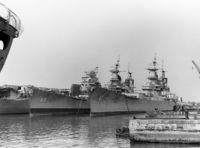
New Jersey remained there until the Strom Thurmond National Defense Authorization Act of 1999 required the Secretary of the Navy to list and maintain Iowa and Wisconsin on the Naval Vessel Register. The Act also required the Secretary of the Navy to strike New Jersey from the Naval Vessel Register and transfer the battleship to a not-for-profit entity in accordance with section 7306 of Title 10 of the United States Code. It also required the transferee to locate the battleship in the state of New Jersey. The Navy made the switch in January 1999, allowing New Jersey to open as a museum ship in her namesake state.
On 17 March 2006, the Secretary of the Navy struck Iowa and Wisconsin from the NVR, which cleared the way for both ships to be donated for use as museum ships; but the United States Congress remained "deeply concerned" over the loss of the naval surface gunfire support that the battleships provided, and noted that "navy efforts to improve upon, much less replace, this capability have been highly problematic." As a partial consequence, Congress passed the National Defense Authorization Act 2006, requiring that the battleships be kept and maintained in a state of readiness should they ever be needed again. Congress ordered that measures be implemented to ensure that, if need be, Iowa could be returned to active duty. These measures closely mirrored the original three conditions that the National Defense Authorization Act of 1996 which laid out for the maintenance of Iowa while she was in the "mothball fleet".
Iowa's superstructure is decked out in red, white, and blue banners following her official opening as a museum ship in Los Angeles. A display of her ribbons and awards earned during her career can be seen below and to the right of the Phalanx CIWS mount. In March 2007, the Historic Ships Memorial at Pacific Square (HSMPS) of Vallejo, site of the former Mare Island Naval Shipyard, and a Stockton group submitted proposals to use the ship as a museum. The HSMPS, which had attempted to place the ship in San Francisco, supported the Mare Island–Vallejo site. In October 2007 the Navy informed HSMPS that they were the only viable candidate to acquire Iowa, and their application would be further reviewed after evidence was presented that financing was in place, and when the Stockton and San Francisco groups withdrew or failed to submit a final application respectively. On 25 April 2009, Iowa Senate Resolution No. 19 was approved, endorsing HSMPS as USS Iowa's custodian and supporting the battleship's placement at Mare Island.
In February 2010, the Pacific Battleship Center (PBC) supported the efforts to have the ship berthed in San Pedro, Los Angeles, California. In late February, the Port of Los Angeles (which includes the San Pedro area) rejected a proposal by the PBC to berth USS Iowa at its facilities because the battleship was not yet available. On 12 April 2010, the Governor of Iowa signed into law Bill SJR2007, which officially formed a 10-member committee to raise about $5 million for the group awarded USS Iowa. The statement supporting the Vallejo group in the original Iowa State Senate's version SR19 was struck in favor of supporting any group actually awarded the battleship.
On 13 May 2010, the Navy announced it would reopen the bidding process, citing HSMPS's lack of progress as the reason. On 24 May 2010, the Federal Register officially reopened the bidding process for USS Iowa to a California-based city or non-profit organization.
On 18 November 2010, the Port of Los Angeles Harbor Commissioners voted unanimously on a resolution to support Berth 87 as the future home of USS Iowa, clearing the way for The Pacific Battleship Center to send its completed application to the Navy. On 6 September 2011, USS Iowa was awarded to Pacific Battleship Center for placement at the Port of Los Angeles. After rehabilitation at the Port of Richmond, California (beginning in October 2011), she was towed to and eventually berthed in the Port of Los Angeles.
Starting in December 2011, USS Iowa was open for weekend tours. The Battleship Expo at the Port of Richmond included shipboard access and other exhibits such as 16-inch shells, a short film about the battleship, and other exhibits. On 30 April 2012, USS Iowa was officially donated to the Pacific Battleship Center in Los Angeles by the United States Navy.
Iowa began her journey to the Port of Los Angeles on 26 May 2012 under tow by four Crowley Maritime tugboats. After being anchored off the Southern California coast to have her hull scrubbed to remove any invasive species or contaminants, on 9 June 2012 she was permanently docked in San Pedro at Berth 87, along the Main Channel, directly south of the World Cruise Center. The museum opened to the public on 7 July, under the direction and control of Pacific Battleship Center.
Notes
- ↑ Dahlgren Virginia is about fifteen miles south of Washington, DC
External links
- USS Iowa – Pacific Battleship Center, official museum site
- Map and satellite image from Google Maps
- Maritimequest USS Iowa BB-61 Photo Gallery
Chat rooms • What links here • Copyright info • Contact information • Category:Root
